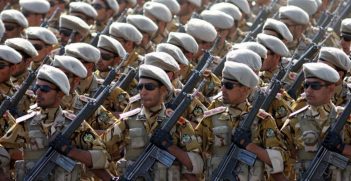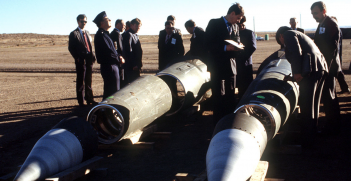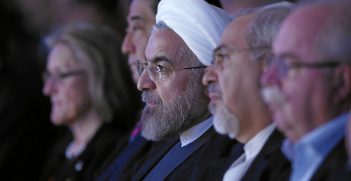The Ideology of Iran (Part Two)

Iran’s ideology is driven by a need to defend Shiia Islam, with the goal of being recognised and treated as a key player in the regional political, cultural, economic, and security architecture.
This article is a continuation of Paul Buchanan’s article “Iran As A Strategic Actor.”
The ideological element in Iran is twofold: it sees itself as a global defender of Shiia Islam, to include defending against “Crusader” and Sunni Muslim encroachments on traditionally Shiite land and people; and it is anti-imperialist in its rejection of distant (again, Judeo-Christian) great power interference in the Middle East. Some of this bleeds into anti-Semitism and militant anti-US sentiment as well as sectarian hatred of Sunni Muslims.
The influence of the ideological element ebbs and flows depending on the level of threat perceived by the regime and the specific policy arena in question. The more Iran is threatened by external actors and/or internal dissent tied to foreign interests, the more ideological hardliners dominate policy debates. The more secure the regime feels, the more it is the case that moderate and pragmatic views prevail. Even so, some policy arenas such as the nuclear program and foreign affairs remain consistently pragmatic in orientation, whereas others, including those involved in administration of social mores and outreach to armed foreign allies, are more ideologically driven.
A cornerstone of Iran’s geopolitical outlook is to be recognised and treated as a principle in the regional political, cultural, economic, and security architecture. It sees itself as a regional power, a bridge between Central Asia and the Middle East and a counterweight to Sunni Arab influence. Because it sees itself as vulnerable due to its geographic location, Iranian strategic policy emphasises deterrence through denial. This requires a large conventional standing army as a defensive bulwark against territorial encroachment; strong anti-air defences as a shield against airborne attacks; a mobile, stealthy and manoeuvrable navy with anti-access and area denial capabilities; ballistic missile forces for deterrence and offensive strikes against sea- and land-based distant threats; a robust cyber warfare capability for defensive and offensive purposes and a network of irregular proxy forces marshalled on ideological lines that are deployed to bolster allies and keep adversaries off-balance and focused on rear-guard defence.
Perversely, the more Iran attempts to bolster its security in the face of multi-front vulnerabilities and its continued marginalisation in international fora, the more it creates a classic security dilemma whereby its rivals perceive its strengthening as a threat and respond by increasing their own arsenals. There is irony in this. With the exception of the proxy forces and offensive potential of its cyber warfare and ballistic missile forces, the thrust of Iranian military strategy is pragmatic and defensive in nature.
This does not mean that it will not project power to defends its interests and send messages to adversaries. This is seen in recent events. The precision drone and missile strikes against Saudi oil facilities attributed to Iran were in direct response to the Saudi-led scorched earth campaign against Shite Houthi rebels in Yemen. The hijacking of British-flagged oil tankers by suspected revolutionary guard commandos was in response to British seizure of an Iranian flagged tanker off Gibraltar. Downing of US military drones happened when they encroached on Iranian airspace. The deployment of Revolutionary Guards and Hezbollah in Syria was in defence of a co-religionist regional ally against Sunni rebels, including those grouped under the banner of ISIS.
Even its much-condemned support for Shiite militias that have killed scores of US troops in Iraq has a pragmatic rationale. Whatever the justification for invading Iraq and removing the Hussein regime, both before and after the defeat of ISIS in Iraq, US troops have been seen as an occupation force. They were attacked by Shiite militias such as the Mahdi Army in the immediate post-Saddam period, and they are attacked by its successor Saraya Al Salam today. The irony is that these militias were vital to the anti-ISIA fight in Iraq and enjoyed US support during joint operations against that common enemy. Now, the Iranian goal is to use its Iraqi proxies to remove, via a “death by a thousand cuts” battle plan, a major adversary from what for Iran is a critically important buffer state, something that will allow it to consolidate its influence in its domestic politics given the Shiite demographic majority and in the face of Sunni and Kurdish Iraqi contestation of its presence.
Iranian pragmatism is seen in its quest for nuclear weapons. Iran wants to demonstrate a nuclear weapons delivery capability so as to deter aggression by its enemies, especially the US and Israel. To do so it requires three things: weapons grade fissile material (90 percent uranium 235 (U235)) or 93 percent reprocessed plutonium (Pu239); a means of delivery (ballistic missiles); and the ability to miniaturise a nuclear weapon so that it fits in the nose cone of a ballistic missile. Iran has opted to enrich uranium for its weapons program, has developed short- and intermediate range ballistic missiles with Circular Error Probable (CEP) targeting accuracy compatible with nuclear warheads, and its working on its weapons miniaturisation capabilities.
Iran has publicly renounced a first-strike option for its nuclear weapons and has instead spoken of using nuclear weapons only if attacked (unlike the US, which has not renounced the pre-emptive first-strike option). However, the international community fears that an Iranian nuclear weapons capability will precipitate a nuclear arms race with Sunni Arab countries and/or a pre-emptive attack by nuclear-armed Israel. These concerns have prompted repeated attempts to dissuade the Iranians from pursing a nuclear weapons program, culminating in the ill-fated Joint Comprehensive Plan of Action (JCPOA) that the US unilaterally abandoned in 2018. The JCPOA, signed by the US, France, Britain, China, Russia, and Germany (P5+1) with Iran, focused on curtailing Iranian uranium enrichment efforts in exchange for the lifting of economic sanctions and have not had an impact on its missile development or warhead miniaturisation efforts. Iran complied with the JCPOA until the US unilaterally withdrew from it in 2017, and only resumed full-scale enrichment efforts after the US unilaterally re-imposed economic sanctions and then undertook the “signature strike” against General Soleimani.
The risks to those involved in the Iranian nuclear program extend beyond international sanctions. From January 2010 through January 2012 five people associated with the Iranian nuclear weapons program were assassinated in Iran by Israeli agents. This followed a 2007 poison attack in Tehran on another Iranian physicist, also attributed to Mossad. In retaliation, in February 2012 Iranian agents attempted bombing attacks on Israeli targets in Georgia, India, and Thailand. The tit-for-tat halted when the US interceded as part of the attempt to coax Iran into joining the P5+1 at the negotiating table. Worth noting is the fact that the Iranian response to the assassinations of its citizens was proportional, focused on symbols of the Israeli state, and demonstrated Iran’s continued ability to conduct long-distance clandestine operations successfully (following a hiatus after the 1992 and 1994 bombings of the Israeli embassy and Jewish Community Center in Buenos Aires, the former coming in response to the killing of Hezbollah leader Abbas al Moussawi).
The bottom line is that the main argument against the Iranian nuclear weapons program has less to do with its projected behaviour once it has them, and more to do with the response such a capability will evoke in the Sunni Arab world and Israel.
This should give pause. Iran may be guilty of unpleasant rhetoric vis-a-vis its major adversaries and it does engage in surreptitious and overt armed activities against them and regional rivals, but in doing so it is no different than other states and displays a rational, pragmatic approach when doing so. Moreover, the “all stick, no carrot” approach adopted by the US under the Trump administration ignores the history of successful diplomacy with Iran and encourages the dominance of hardliners in internal debates about how Iran should engage generally and respond specifically to external events and conditions.
A close reading of Persian history and of its strategic culture suggests that if nothing else and regardless of who rules it, Iran knows how to play the geopolitical long game, and it does so rationally. It therefore behoves adversaries, allies, and honest interlocutors alike to understand this when addressing its legitimate concerns and immediate grievances.
Dr Paul G. Buchanan is the Director of 36th Parallel Assessments, an Auckland-based geopolitical and strategic analysis consultancy.
This article is published under a Creative Commons Licence and may be republished with attribution.





